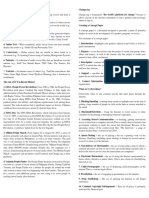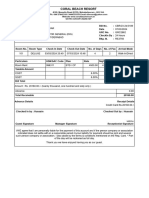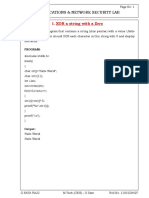0 ratings0% found this document useful (0 votes)
Reviewer in Pr1 Qtr3
Reviewer in Pr1 Qtr3
Uploaded by
Jovelle DiazThe document discusses key considerations in formulating a research problem and conducting qualitative research. It defines qualitative research as using words rather than numbers to express results. It also outlines various types of qualitative research including case studies, ethnography, phenomenology, content analysis, historical analysis, and grounded theory. The document notes advantages of qualitative research like understanding human behavior naturally and facilitating social change, and disadvantages such as subjectivity and data overload requiring long analysis. It also discusses external criteria for a good research problem like novelty, availability of subjects, and community support.
Copyright:
© All Rights Reserved
Available Formats
Download as PDF, TXT or read online from Scribd
Download as pdf or txt
Reviewer in Pr1 Qtr3
Reviewer in Pr1 Qtr3
Uploaded by
Jovelle Diaz0 ratings0% found this document useful (0 votes)
The document discusses key considerations in formulating a research problem and conducting qualitative research. It defines qualitative research as using words rather than numbers to express results. It also outlines various types of qualitative research including case studies, ethnography, phenomenology, content analysis, historical analysis, and grounded theory. The document notes advantages of qualitative research like understanding human behavior naturally and facilitating social change, and disadvantages such as subjectivity and data overload requiring long analysis. It also discusses external criteria for a good research problem like novelty, availability of subjects, and community support.
Copyright
© © All Rights Reserved
Available Formats
PDF, TXT or read online from Scribd
Share this document
Did you find this document useful?
Is this content inappropriate?
The document discusses key considerations in formulating a research problem and conducting qualitative research. It defines qualitative research as using words rather than numbers to express results. It also outlines various types of qualitative research including case studies, ethnography, phenomenology, content analysis, historical analysis, and grounded theory. The document notes advantages of qualitative research like understanding human behavior naturally and facilitating social change, and disadvantages such as subjectivity and data overload requiring long analysis. It also discusses external criteria for a good research problem like novelty, availability of subjects, and community support.
Copyright:
© All Rights Reserved
Available Formats
Download as PDF, TXT or read online from Scribd
Download as pdf or txt
0 ratings0% found this document useful (0 votes)
Reviewer in Pr1 Qtr3
Reviewer in Pr1 Qtr3
Uploaded by
Jovelle DiazThe document discusses key considerations in formulating a research problem and conducting qualitative research. It defines qualitative research as using words rather than numbers to express results. It also outlines various types of qualitative research including case studies, ethnography, phenomenology, content analysis, historical analysis, and grounded theory. The document notes advantages of qualitative research like understanding human behavior naturally and facilitating social change, and disadvantages such as subjectivity and data overload requiring long analysis. It also discusses external criteria for a good research problem like novelty, availability of subjects, and community support.
Copyright:
© All Rights Reserved
Available Formats
Download as PDF, TXT or read online from Scribd
Download as pdf or txt
You are on page 1/ 2
Reviewer in Practical Research 1_Qtr 3 investigation about people’s thoughts, beliefs, feelings,
views, and lifestyles regarding the object of the study.
Characteristics of Research
(Cristobal & Cristobal, 2017) Quantitative research involves measurement of data.
Thus, it presents research findings referring to the
1. Research should be systematic. - The researcher number of frequencies of something in numerical forms
needs to carry out a series of interrelated steps in like using percentages, fractions and numbers.
conducting the study.
2. Research should be objective. - The researcher Types of Qualitative Research
needs to present information that are purely based on
truths. 1. Case Study - This type of qualitative research usually
3. Research should be feasible. - The researcher needs takes place in the field of social care, nursing,
to consider the possibility and practicality of conducting psychology, rehabilitation centers, education, etc. This
the proposed study. involves a long-time study of a person, group,
4. Research should be empirical. - The researcher organization, or situation. It seeks to find answers to
needs to employ appropriate methods, either why such thing occurs to the subject
quantitatively or qualitatively, to produce evidence- 2. Ethnography - Falling in the field of anthropology,
based information. ethnography is the study of a particular cultural group to
5. Research should be clear. - The researcher needs to get a clear understanding of its organizational set-up,
use comprehensible language to present information and internal operation, and lifestyle.
convey explanation throughout the research process. 3. Phenomenology - Coming from the word
“phenomenon,” which means something known through
Characteristics of Research (LAS) sensory experience, phenomenology refers to the study
of how people find their experiences meaningful.
4. Content and Discourse - Analysis Content analysis
1. Accuracy. It must give a precise, exact or accurate
is a method of quantitative research that requires an
data, every entry should honestly, and appropriately
analysis or examination of the substance or content of
documented or acknowledged.
the mode of communication (letters, books, journals,
2. Objectiveness. It must deal with facts, should
photos, video recordings, SMS, online messages, emails,
objectively look at the basis on which the work is
audio-visual materials, etc.) used by a person, group,
founded.
organization, or any institution in communicating.
3. Timeliness. It must work on a topic that is fresh, new
5. Historical - Analysis Central to this qualitative
and interesting to the present society.
research method is the examination of primary
4. Clarity. It must succeed in expressing its central
documents to make you understand the connection of
point, by using simple, direct, concise and correct
past events to the present time.
language.
6. Grounded - Theory Grounded theory takes place
5. Relevance. Its topic must be useful in improving our
when you discover a new theory to underlie your study
society or in solving a particular problem that affecting
at the time of data collection and analysis. Through your
the lives of people in the community.
observation on your subjects, you will happen to find a
6. Systematic. It must take a place in an organized or
theory that applies to your current study.
orderly manner.
Advantages or Strengths of Qualitative Research
Types of Research
1. It adopts a naturalistic approach to its subject matter,
1. Descriptive Research- this type of research aims at
which means that those involve in the research
defining or giving a verbal portrayal or picture of a
understand things based on what they find meaningful.
person, thing, event, group, situation, etc.
2. It promotes a full understanding of human behavior or
2. Correlational research- a correlational research
personality traits in their natural setting.
shows relationships or connectedness of two factors,
3. It is instrumental for positive societal changes.
circumstances, or agents called variables that affect the
4. It engenders respect for people’s individuality as it
research.
demands the researcher’s careful and attentive stand
3. Explanatory Research- this type of research
toward people’s world views.
elaborates or explains not just the reasons behind the
5. It is a way of understanding and interpreting social
relationship f two factors, but also the ways by which
interactions.
such relationship exists.
6. It increases the researcher’s interest in the study as it
4. Exploratory Research- an exploratory research’s
includes the researcher’s experience or background
purpose is to find out how reasonable or possible it is to
knowledge in interpreting verbal and visual data.
conduct a research study on a certain topic.
7. It offers multiple ways of acquiring and examining
5. Action Research- this type of research studies an knowledge about something.
ongoing practice of a school, organization, community,
or institution for the purpose of obtaining results that Disadvantages or Weaknesses of Qualitative
will bring improvements in the system. Research
1. It involves a lot of researcher’s subjectivity in data
Qualitative and Quantitative Research Methods analysis.
2. It is hard to know the validity or reliability of the data.
Qualitative research requires non-numerical data, 3. Its open-ended questions yield “data overload” that
which means that the research uses words rather than requires long-time analysis.
numbers to express the results, the inquiry, or 4. It is time-consuming.
5. It involves several processes, which results greatly
depend on the researcher’s views or interpretations. 1. Population – According to Majid (2018), this stands
for the entire pool from which the sample is drawn.
CONSIDERATIONS IN FORMULATING THE 2. Research Locale – It refers to the particular location
RESEARCH PROBLEM where the study is conducted.
3. Specific Duration - This stands for the exclusive
External Criteria time frame when the research is conducted.
4. Research Method – This refers to the systematic plan
Novelty – This refers to the practical value of the for conducting research which includes strategies,
problem due to its “newness” in the field of inquiry process, techniques, and procedures for collecting and
Availability of subjects – This refers to the people with analyzing data (MacDonald and Headlam 2008).
the desired capability and willingness to participate in 5. Protocols Followed. This refers to the standard
the study. procedure, system, or rules that you follow in gathering
Support of the academic community – This refers to data. It can be the permission in the conduct of the study,
the assistance given by the members of the institution, communication letter to the respondents, or agreement
like the principal, teachers, staff, students, and the on the conduct of interview.
parents, in the gathering of data and defraying the cost 6. Data Gathering Procedure - This refers to the step-
of the study. by-step procedures that you employ before and during
Availability and adequacy of facilities and equipment the data gathering.
– Devices such as computers, and telephones used in 7. Instrument - These are measurement devices that
undertaking the study must be considered. you use in your research. It can be in a form of test,
Ethical considerations – These include the avoidance survey, questionnaire, and the like.
of research problems that pose unethical demands on the 8. Data Analysis -These are the systematical processes
part of the research participants you employ to describe or interpret your data.
Internal Criteria The Research Phase
Experience, training, and qualifications of the
researcher – These constitute the researcher’s
knowledge and expertise as a result of experience and
study.
Motivation, interest, intellectual curiosity, and
perceptiveness of the researcher – These are essential
attitudes that bring anticipated satisfaction or enjoyment
in the completion of research tasks.
Time factor – This considers the fact that studies must
be pursued within a given time frame.
Costs and returns – These factors matter in choosing a
research problem. Research is an expensive undertaking.
Hazards, penalties, and handicaps – These depend
upon the researcher’s physical and intellectual capacity
and moral judgment
A research title prefaces the study by providing a
summary of the main idea and is usually short and Chapter 1: The Problem and Its Background
concise. A. Introduction, Background of the Study
B. Statement of the Problem
Characteristics of a Research Title
1. It should summarize the main idea of the paper. C. Scope and Delimitation
2. It should be a concise statement of the main topic. D. Significance of the Study
3. It should include the major variables of the research Chapter 2: Theoretical Framework
study.
A. Review of Related Literature
4. It should be self-explanatory.
5. It should describe or imply the participants B. Review of Related Studies
of the study C. Conceptual/Theoretical Framework
Five Main Steps in Writing a Research Title D. Definition of Terms
1. Ask yourself a few questions about your research
paper
2. Identify and list keywords and phrases from these
responses
3. Use these keywords to create one long sentence
4. Create a working title
5. Eliminate all extra words or phrases to meet a suitable
word count. (Average length is 16 words)
Fundamental Elements of Scope and Delimitation
You might also like
- Reframed - A Journal of Self-Reg - Volume 1, Issue 1No ratings yetReframed - A Journal of Self-Reg - Volume 1, Issue 1117 pages
- Poems From The Desert - Mohammed Bin Rashid Al Maktoum100% (3)Poems From The Desert - Mohammed Bin Rashid Al Maktoum16 pages
- Rock Forming Minerals and Igneous RocksNo ratings yetRock Forming Minerals and Igneous Rocks25 pages
- 1 - 2exploring Random Variables CG 1 AND 2 Lesson1100% (1)1 - 2exploring Random Variables CG 1 AND 2 Lesson116 pages
- 1q3 Module1 Week1 Rws11 Afniñalga 2021-2022No ratings yet1q3 Module1 Week1 Rws11 Afniñalga 2021-20228 pages
- What I Need To Know: Activity 2: Timeline of EventsNo ratings yetWhat I Need To Know: Activity 2: Timeline of Events16 pages
- Readingandwriting11 q3 Mod6 Identifyingclaims-V3 PDFNo ratings yetReadingandwriting11 q3 Mod6 Identifyingclaims-V3 PDF11 pages
- 21st Century Lit11 Q1 M2 Conventional 21st Century Conventional GenresNo ratings yet21st Century Lit11 Q1 M2 Conventional 21st Century Conventional Genres24 pages
- DRRR 11 - 12 Q1 0101 The Concept of Disaster and Disaster Risk PSNo ratings yetDRRR 11 - 12 Q1 0101 The Concept of Disaster and Disaster Risk PS19 pages
- Empowerment Technologies: "Read Only Web"No ratings yetEmpowerment Technologies: "Read Only Web"5 pages
- 18-19. ADMModule - STEM - GP12KIN-Ib-18-19No ratings yet18-19. ADMModule - STEM - GP12KIN-Ib-18-1926 pages
- Module 3-Random Sampling and Sampling DistributionNo ratings yetModule 3-Random Sampling and Sampling Distribution65 pages
- Advantages and Disadvantages of A Qualitative ResearchNo ratings yetAdvantages and Disadvantages of A Qualitative Research1 page
- Phisical and Chemical Properties of Rocks and MineralsNo ratings yetPhisical and Chemical Properties of Rocks and Minerals19 pages
- 6.8 - Pascal's Triangle and The Binomial TheoremNo ratings yet6.8 - Pascal's Triangle and The Binomial Theorem14 pages
- Lesson 1 - Familiarizing - With - Digital - SoftwareNo ratings yetLesson 1 - Familiarizing - With - Digital - Software2 pages
- PDF (SG) - EAP 11 - 12 - UNIT 11 - LESSON 3 - Preparing and Administering Data CollectionNo ratings yetPDF (SG) - EAP 11 - 12 - UNIT 11 - LESSON 3 - Preparing and Administering Data Collection15 pages
- L 08910 Hyper Poetry Text Tula Blog and 2No ratings yetL 08910 Hyper Poetry Text Tula Blog and 219 pages
- Techniques in Summarizing Variety of Academic TextsNo ratings yetTechniques in Summarizing Variety of Academic Texts120 pages
- FINAL (PS) - PR1 11 - 12 - UNIT 5 - LESSON 4 - Designing Instruments For Data CollectionNo ratings yetFINAL (PS) - PR1 11 - 12 - UNIT 5 - LESSON 4 - Designing Instruments For Data Collection31 pages
- 1 Null Alternative Hypothesis SPTC 1301 Q4 FPFNo ratings yet1 Null Alternative Hypothesis SPTC 1301 Q4 FPF36 pages
- Jawaharlal Nehru Technological University KakinadaNo ratings yetJawaharlal Nehru Technological University Kakinada8 pages
- The Red Pill For Boys - 8 Female Sexual PsychologyNo ratings yetThe Red Pill For Boys - 8 Female Sexual Psychology17 pages
- ADJECTIVESnPARTn1nnn895fb56974abf5dnnn 245fb5de15f111aNo ratings yetADJECTIVESnPARTn1nnn895fb56974abf5dnnn 245fb5de15f111a11 pages
- GPS Geodetik E 300 E Survey STATIK ONLY - TRANSSURVEYNo ratings yetGPS Geodetik E 300 E Survey STATIK ONLY - TRANSSURVEY2 pages
- Christian Marriage Registration - Bishop, Pastor and Licensee - Login - Portal - User ManualNo ratings yetChristian Marriage Registration - Bishop, Pastor and Licensee - Login - Portal - User Manual17 pages
- Big Data and Business Analytics (LO A B C)No ratings yetBig Data and Business Analytics (LO A B C)25 pages
- UPSC IAS Prelims GS - General Studies Question Paper 1995 With AnswersNo ratings yetUPSC IAS Prelims GS - General Studies Question Paper 1995 With Answers47 pages
- Exploration of TCP Parameters For Enhanced Performance in A Datacenter EnvironmentNo ratings yetExploration of TCP Parameters For Enhanced Performance in A Datacenter Environment5 pages
- Financial Management II Assignment Complete100% (1)Financial Management II Assignment Complete25 pages
- Unit: 1 Derivatives: Deriving Verbs From NounsNo ratings yetUnit: 1 Derivatives: Deriving Verbs From Nouns4 pages
- dm2020 0186 Interim Guidelines On Operations of Converted P and P Spaces Into TTMF PDFNo ratings yetdm2020 0186 Interim Guidelines On Operations of Converted P and P Spaces Into TTMF PDF27 pages

























































































